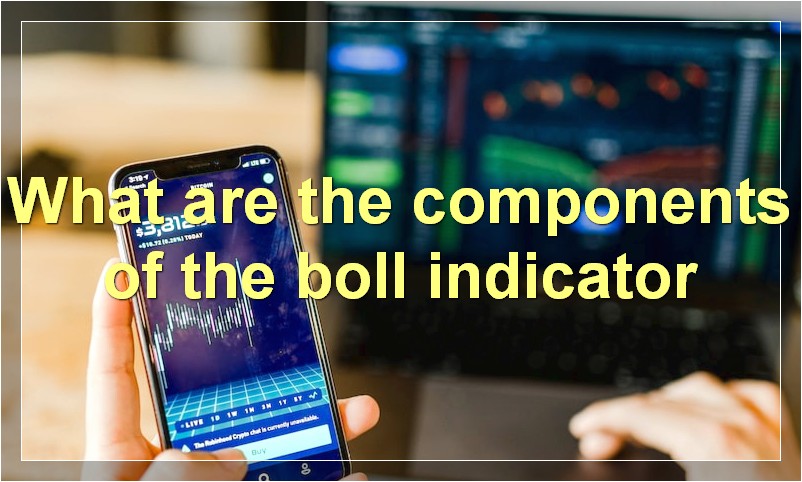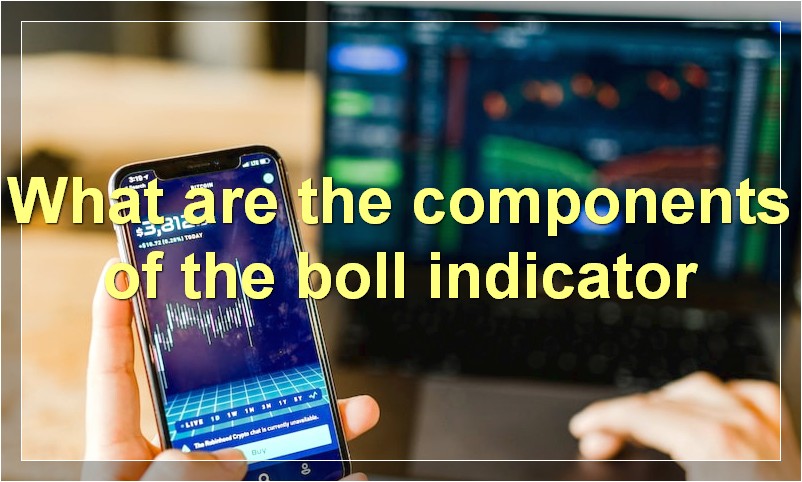The Boll Indicator is a technical analysis tool that can help you make better-informed trading decisions.
What is the boll indicator
The Bollinger Bands indicator is one of the most popular technical indicators used by traders in all markets, including forex. Bollinger Bands are a volatility indicator that provides a band of resistance and support around a moving average line. The standard deviation of price action is used to calculate the width of the bands.
Bollinger Bands can be used to trade a variety of market conditions, including breakouts, trend continuation, and reversals. When the market is in a period of high volatility, the Bollinger Bands will expand. In low volatility periods, the Bollinger Bands contract.
The Bollinger Bands indicator can be used in conjunction with other technical indicators to form a complete trading system. Some common indicators that are often used with Bollinger Bands include moving averages, RSI, and MACD.
What are the components of the boll indicator

The boll indicator is a technical analysis tool used by traders to measure market volatility. The indicator is composed of three lines: the upper line, lower line, and middle line. The upper and lower lines are determined by calculating the standard deviation of the past 20 days’ closing prices. The middle line is a simple moving average of the past 20 days’ closing prices.
The boll indicator can be used to identify market trends and reversals, as well as to measure the strength of a trend. When the market is in an uptrend, the prices will tend to stay above the middle line. Conversely, when the market is in a downtrend, prices will tend to stay below the middle line. If prices break out above or below the upper or lower line, this could signal a change in trend.
The boll indicator can also be used to measure market volatility. When markets are more volatile, the distance between the upper and lower lines will widen. When markets are less volatile, the distance between the lines will narrow.
Traders often use the boll indicator in conjunction with other technical indicators to make trading decisions. For example, if prices break out above the upper line, traders might look for confirmation from another indicator before entering a long position. Similarly, if prices break out below the lower line, traders might look for confirmation from another indicator before entering a short position.
How is the boll indicator used
The Bollinger Band indicator is used to measure market volatility. It is composed of an upper and lower band that indicate the relative high and low prices of a security, and a moving average in the middle. When the market is volatile, the bands widen and move apart from each other. When the market is relatively stable, the bands contract and move closer together. The boll indicator can be used to measure both long-term and short-term market volatility.
What are the benefits of using the boll indicator
The boll indicator is a technical analysis tool that is used to measure market volatility. The indicator is composed of three lines: the upper line, lower line, and middle line. The upper and lower lines are used to indicate market volatility, while the middle line is used to indicate the market trend. Bollinger bands are often used by traders to identify potential trading opportunities.
Some of the benefits of using the boll indicator include:
1. The ability to measure market volatility – The boll indicator can be used to measure how volatile the market is. This information can be used by traders to make decisions about when to enter or exit a trade.
2. The ability to identify potential trading opportunities – The boll indicator can be used to identify potential trading opportunities. By looking at the position of the lines, traders can get an idea of whether the market is overbought or oversold.
3. The ability to use Bollinger Bands in conjunction with other indicators – Bollinger Bands can be used in conjunction with other technical indicators to help confirm trading signals. For example, if the price breaks out of the upper Bollinger Band, this could be confirmation that a bullish trend is developing.
What are the drawbacks of using the boll indicator
The Bollinger Bands indicator is a widely used technical indicator that is used to measure market volatility. The indicator is created by using a moving average and two standard deviations, which are calculated using historical price data. The Bollinger Bands indicator can be used on any time frame, but is most commonly used on daily or weekly charts.
The main drawback of using the Bollinger Bands indicator is that it is a lagging indicator, which means that it will only provide signals after the fact. This means that traders need to be aware of the potential for false signals, as market conditions can change rapidly and the Bollinger Bands may not adjust quickly enough to reflect these changes.
How does the boll indicator work

The Bollinger Band is a technical indicator that is used to measure market volatility. It consists of an upper and lower band that are placed two standard deviations away from a simple moving average. The bands expand and contract as price action fluctuates.
The Bollinger Band indicator can be used in two ways: to measure market volatility or to identify potential trading opportunities. When market volatility is high, the bands will expand. This means that there is a greater chance for prices to move in either direction. When market volatility is low, the bands will contract. This means that there is less of a chance for prices to move in either direction.
The Bollinger Band indicator can also be used to identify potential trading opportunities. When prices break out above the upper band, it is considered an bullish signal. This means that prices are likely to continue to rise. When prices break out below the lower band, it is considered a bearish signal. This means that prices are likely to continue to fall.
Is the boll indicator reliable
There is no simple answer to this question. The boll indicator is a tool that investors and traders use to try to predict future price movements in the market. Some people believe that it is reliable, while others believe that it is not.
The boll indicator is based on the concept of Bollinger Bands. Bollinger Bands are statistical lines that are plotted above and below an asset’s price on a chart. The upper line is called the upper Bollinger Band, and the lower line is called the lower Bollinger Band.
The space between the two Bollinger Bands is called the Bollinger BandWidth. The width of the Bollinger Bands varies depending on market conditions. When the market is volatile, the Bollinger Bands will be wide, and when the market is calm, the Bollinger Bands will be narrow.
Some people believe that the Bollinger BandWidth can be used to predict future price movements. They think that when the Bollinger BandWidth is wide, prices are likely to fall, and when the Bollinger BandWidth is narrow, prices are likely to rise.
However, there is no evidence that this is actually true. The Bollinger BandWidth is simply a measure of market volatility, and it does not necessarily mean that prices will move in any particular direction. In fact, prices can just as easily go up when the Bollinger BandWidth is wide as they can go down.
So, ultimately, whether or not you believe that the boll indicator is reliable is up to you. If you think that it might be helpful in predicting future price movements, then by all means use it. But if you don’t believe that it is truly predictive, then you may want to steer clear of it.
What are some alternative indicators to the boll indicator
The boll indicator is a technical indicator that is used to measure market volatility. Bollinger Bands are a type of envelope plot that is placed above and below the price plot of a security to indicate the standard deviation of prices. The boll indicator can be used to identify overbought and oversold conditions in the market, as well as to gauge the level of market volatility.
There are a number of alternative indicators to the boll indicator, including the MACD, RSI, and Stochastic Oscillator. Each of these indicators has its own advantages and disadvantages, so it is important to choose the right indicator for your trading strategy. For example, the MACD is a popular momentum indicator that can be used to identify trend reversals, while the RSI is a widely used overbought/oversold indicator. The Stochastic Oscillator is another popular momentum indicator that can be used to identify potential reversal points in the market.
What are some common misconceptions about the boll indicator
The Bollinger Bands® are a technical analysis tool developed by John Bollinger in the 1980s. The bands comprise a simple moving average, typically set at 20 periods, and two “standard deviation” bands above and below the simple moving average. The standard deviation is a measure of volatility, usually based on past prices.
Bollinger Bands are often used to identify market conditions such as overbought or oversold levels, price squeezes, and potential trend reversals. However, Bollinger Bands can also be used to confirm trends, momentum, and breakouts.
One common misconception about Bollinger Bands is that the upper and lower bands always contain 95% of price action. In reality, the percentage of price action contained within the bands varies depending on market conditions.
Another misconception is that prices always bounce off the Bollinger Bands. While prices do tend to reverse direction when they reach an extreme level, this is not always the case. In some instances, prices may continue moving in the same direction even after reaching an extreme level.
Finally, some traders believe that Bollinger Bands can be used to predict future price movements. While Bollinger Bands can provide valuable information about potential market moves, they should not be viewed as a crystal ball.
How can I learn more about the boll indicator
The Bollinger Bands indicator is a technical analysis tool that is used to measure market volatility. The indicator is comprised of three bands: an upper band, a lower band, and a middle band. The middle band is a simple moving average (SMA) of the security’s price, and the upper and lower bands are placed two standard deviations above and below the middle band.
Bollinger Bands are used to help traders identify potential trading opportunities. When the market is volatile, the bands will widen, and when the market is calm, the bands will narrow. A trader might buy a security when the price touches the lower Bollinger Band, in the expectation that the price will rebound back to the middle band or higher. Conversely, a trader might sell a security when the price touches the upper Bollinger Band, in the expectation that the price will fall back to the middle band or lower.
While Bollinger Bands can be used on any time frame, they are most commonly used on daily charts.

